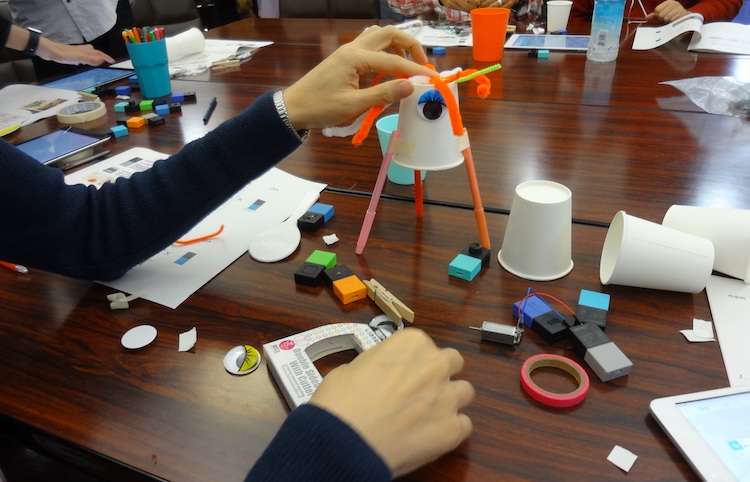MESH, or the magic of wireless prototyping
Published 5 January 2016 by Cherise Fong
Made in Japan, MESH is the latest prototyping kit for all, allowing anyone to playfully appropriate the Internet of Things—the Asian counterpart to U.S. start-up Littlebits and European initiative SAM.
Tokyo, from our correspondent (text and photos)
At a MESH workshop in Yokohama, a cyclops cup starts walking on felt-tipped stilts whenever its creator lifts a plastic barbell. Takehiro Hagiwara, leader of the MESH project at Sony, plays an electric laser-cut wooden guitar—with no strings. In the AssistOn design shop in Harajuku, Tokyo, an assistant waves a Lego airplane through the air, triggering a range of sound effects depending on its orientation and angle of flight.

MESH (“Make, Experience, SHare”) could be considered the Japanese counterpart to Littlebits and SAM, based respectively in the U.S. and the UK, all non-soldering rapid prototyping kits aimed at introducing a mainstream audience to the Internet of Things through plug-and-play, drag-and-drop experiments.
More like SAM, MESH also revolves around the concept of discrete wireless modules, each with a specific function, connected via Bluetooth (BLE), and paired with a dedicated application that uses an intuitive, visual interface. But while SAM’s mini blocks are still recognizable as electronic components, MESH encapsulates all the electronics inside color-coded, icon-stamped, designer dominos, where manipulating this smart eye-candy makes it all the more magic.
A connected brush gets to work thanks to MESH modules:
If Littlebits can be controlled by Arduino, while SAM’s desktop software offers a side window of geeky script for the coding-curious, MESH connects all the dots exclusively in a mobile application via the touchscreen of an iPad or iPhone. All wireless, all the time, bringing the prototyping game even further into the real world of things.
Presentation video of MESH project:
Born from an experimental project developed at Sony Japan in 2012, unveiled at Maker Faire Bay Area in May 2014 and crowdfunded from January 2015, MESH finally launched in July 2015. So far, the MESH kit offers only 7 distinct modules: button, LED, “move” orientation sensor, motion sensor, brightness sensor, temperature sensor and GPIO (General Purpose Input Output). This last unit appears to be MESH’s advanced shortcut to connecting external sensors and actuators, most notably servomotors, to get the ball rolling.
And for those who wish to take the project even further, the MESH SDK beta version is now available for programming your own modules using Javascript.
Since November 2015, all MESH modules can be purchased individually or as a kit at the AssistOn shop in Tokyo, as well as online at Amazon.co.jp, Yahoo.co.jp or Switch Science in Japan, or partially on Amazon.com in the U.S. ($50-$200). Despite the limited range of modules and relatively high price point, AssistOn has already sold about a hundred items, including the bestselling “move” module. For now, they are still unavailable for purchase in Europe, but the MESH project is just taking off…

